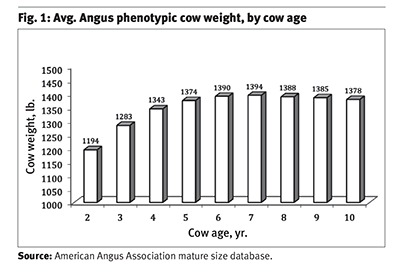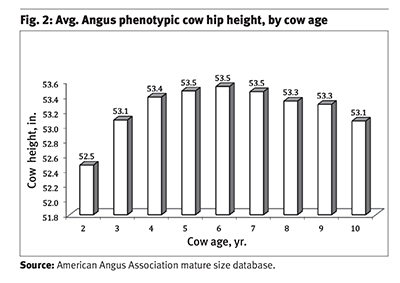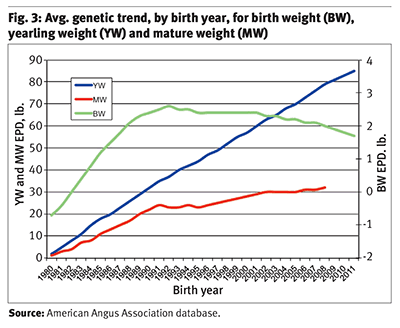
Sally Northcutt
Association Perspective
What does an Angus cow weigh?
A frequent question to our office is: What does an average Angus cow weigh? Some of the interest stems from the Association’s publication of mature size expected progeny differences (EPDs) and the use of these genetic values in the weaned calf ($W) bioeconomic index. In an effort to answer the popular question, let’s examine the phenotypic database on hand in Angus Herd Improvement Records (AHIR®).
 Cow weight, height measures
Cow weight, height measures
Using a database of phenotypic measures on cows taken at various ages, a summary of average weight and height by cow age group is presented in Figs. 1 and 2. The data set includes 319,621 females from 2 to 10 years of age.
Note in Fig. 1 that cow weight levels off at about 5 to 7 years of age. Cows tend to reach their mature weight at about this time. Cow mature height is reached at an earlier age (see Fig. 2). Granted, these trends are illustrated with phenotypic measures, where phenotype is simply the weight or height that is submitted to AHIR, or that observable measure taken by the breeder. Also, to assess these measures by cow age group independent of body condition differences, the cow weights were adjusted to a body condition score (BCS) 6.
 Beyond weights and heights
Beyond weights and heights
Beyond satisfying our curiosity for what a cow weighs, we can utilize these data points on cows at various ages in the Angus breed in the calculation of mature size EPDs. Both cow weight and height are highly heritable (0.37 and 0.64, respectively), indicating that selection for these traits can be effective in a breeding program.
Weight and height are also genetically correlated (+0.75) in a positive direction, so many of the genes that control weight also control height in the same direction. Thus, heavier animals tend to be taller, although this is not a perfect correlation of 1.0.
To examine the genetic change in cow weight over time, Fig. 3 depicts the average mature cow EPD by birth year. Genetic trends for all traits, as reported in the Spring 2013 National Cattle Evaluation (NCE), can be found at www.angus.org/Nce/GeneticTrends.aspx.
 The red line in Fig. 3 illustrates the genetic trend, or average EPD by year, for cow weight up to 2003. The trend is not as rapid as that shown for yearling weight (blue line).
The red line in Fig. 3 illustrates the genetic trend, or average EPD by year, for cow weight up to 2003. The trend is not as rapid as that shown for yearling weight (blue line).
As additional data are submitted on cows of various ages, it will be interesting to see if the mature-cow-weight trend climbs any more or stays relatively flat. Note birth weight has stayed relatively flat and has begun to decline, even when selection pressure was placed on other weight traits.
The mature-weight EPDs are the most meaningful approach to assessing cow weight from a genetic standpoint. These EPDs account for relationships among animals and have been corrected for environmental differences. Also, the mature size EPDs are used as genetic components of the bioeconomic dollar value indexes ($Values) for weaned calf value ($W) and cow energy value ($EN).
To read more about the Angus $Values go to www.angus.org/Nce/ValueIndexes.aspx.
Editor's Note: Sally Northcutt is the director of genetic research for the American Angus Association.
[Click here to go to the top of the page.]





